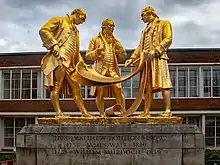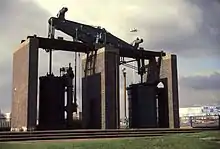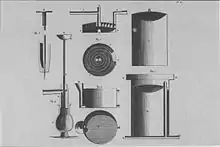 Statue of Boulton, Watt and Murdoch in Birmingham | |
| Type | General partnership |
|---|---|
| Industry | Engineering, manufacturing |
| Founded | Birmingham, England (1775) |
| Founder | Matthew Boulton and James Watt |
| Defunct | c. 1895 |
Key people | Matthew Boulton James Watt William Murdoch |
| Products | Steam engines (stationary and marine) |
| Services | Engineering consulting |
Boulton & Watt was an early British engineering and manufacturing firm in the business of designing and making marine and stationary steam engines. Founded in the English West Midlands around Birmingham in 1775 as a partnership between the English manufacturer Matthew Boulton and the Scottish engineer James Watt, the firm had a major role in the Industrial Revolution and grew to be a major producer of steam engines in the 19th century.
The engine partnership

(Location: 52°29′33″N 1°53′17″W / 52.492537°N 1.888189°W)
The partnership was formed in 1775 to exploit Watt's patent for a steam engine with a separate condenser.[1] This made much more efficient use of its fuel than the older Newcomen engine. Initially the business was based at the Soho Manufactory near Boulton's Soho House on the southern edge of the then-rural parish of Handsworth. However most of the components for their engines were made by others, for example the cylinders by John Wilkinson.
In 1795, they began to make steam engines themselves at their Soho Foundry in Smethwick, near Birmingham, England. The partnership was passed to two of their sons in 1800. William Murdoch was made a partner of the firm in 1810, where he remained until his retirement 20 years later at the age of 76. The firm lasted over 120 years, albeit renamed "James Watt & Co." in 1849, and was still making steam engines in 1895, when it was sold to W & T Avery Ltd.
For ten years their banker in London was Charlotte Matthews after her husband died in 1792. A woman banker was unusual but she became a close confidante, holidaying with Boulton, and she lent them enormous sums to fund their endeavours. When she died aged 43 in 1802 her business was run by the Boulton and Watt families.[2]
The business trained young engineers who went on to achieve notability. Among the names which were employed there in the eighteenth century were James Law, Peter Ewart, William Brunton, Isaac Perrins, William Murdoch, and John Southern.[3]
Archive

The firm left an extremely detailed archive of its activities, which was given to the city of Birmingham in 1911 and is kept at the Library of Birmingham. An additional archive was donated to the Boulton and Watt collection in 2015 including a thesis.[4] The archive contains: Display folders containing text and varieties of drawings.
Preserved operational engines
- Smethwick Engine, Thinktank, Birmingham Science Museum, manufactured 1779.
- Whitbread Engine, Powerhouse Museum, Sydney, manufactured 1785, 25-inch (64 cm) bore, 72-inch (180 cm) stroke.
- Crofton Pumping Station manufactured 1812, 42+1⁄4-inch (107 cm) bore, 84-inch (210 cm) stroke.
- Kew Bridge Steam Museum manufactured 1820, 64-inch (160 cm) bore, 96-inch (240 cm) stroke.[5]
- Papplewick Pumping Station two engines, manufactured 1884, 46-inch (120 cm) bore, 90-inch (230 cm) stroke. Believed to be the last engines manufactured by the company.[6]
See also
References
- ↑ Roll, Erich (1930). An Early Experiment in Industrial Organisation : being a History of the Firm of Boulton & Watt, 1775-1805. Longmans, Green and Co. p. 320.
- ↑ Matthew, H. C. G.; Harrison, B., eds. (23 September 2004), "The Oxford Dictionary of National Biography", The Oxford Dictionary of National Biography, Oxford: Oxford University Press, pp. ref:odnb/70352, doi:10.1093/ref:odnb/70352, retrieved 7 January 2023
- ↑ Buchanan, R. A. (1978). "Steam and the engineering community in the eighteenth century". Transactions of the Newcomen Society. 50: 198.
- ↑ Dr John Richardson (Accession number 2015/049) P.h.D.thesis, University of Reading, 1989.
- ↑ "The Boulton and Watt Engine". Kew Bridge Steam Museum. Archived from the original on 1 June 2008. Retrieved 8 August 2011.
- ↑ "Last engines manufactured". Papplewick Pumping Station Trust. Archived from the original on 3 May 2017. Retrieved 7 May 2017.
Further reading
- Hills, Richard L. (2002). James Watt: His Time in Scotland (1736-1774). Landmark Publishing. ISBN 1-84306-045-0.
External links
- The Non-Rotative Beam Engine Chapter 3: The Boulton and Watt Engine Archived 17 August 2019 at the Wayback Machine Maurice Kelly ISBN 0-9536523-3-5
- Archives of Soho Archived 31 October 2011 at the Wayback Machine at Birmingham Central Library.
- Revolutionary Players website
- Cornwall Record Office Boulton & Watt letters
